Cyberbullying
As you know, there’s been some talk in the media about cyberbullying,
where students publish obscene or defamatory pictures or statements
online for the purpose of hurting others.
To what extent has each of the following experienced cyberbullying?
All Respondents
| |
|
definitely experienced |
definitely not |
|
| |
| yourself personally |
4.7 |
84 |
3 |
3 |
2 |
5 |
4 |
| other teachers or administrators in your school |
3.7 |
41 |
16 |
11 |
9 |
12 |
11 |
| your students |
3.3 |
33 |
11 |
14 |
12 |
18 |
11 |
| students in your school |
2.7 |
16 |
13 |
19 |
17 |
25 |
10 |
French-language Respondents
| |
|
definitely experienced |
definitely not |
|
| |
| yourself personally |
4.8 |
93 |
0 |
7 |
0 |
0 |
0 |
| other teachers or administrators in your school |
3.6 |
38 |
19 |
19 |
13 |
13 |
0 |
| your students |
3.3 |
21 |
21 |
29 |
21 |
7 |
0 |
| students in your school |
2.9 |
14 |
7 |
43 |
21 |
14 |
0 |
In what form have those incidents of cyberbullying typically occurred?
- e-mail
- chatroom or bashboard content
- content on personal web sites or blogs
- text messaging
- photographs or video clips
- personal voting-booth web sites
DNK (do not know/no opinion)
|
 |
How serious are each of the following types of cyberbullying in
e-mail or on a web site?
| |
|
very serious |
not serious |
|
| |
| criticism of a teacher’s clothing, appearance
or mannerisms |
2.3 |
8 |
12 |
21 |
21 |
35 |
3 |
| criticism of a teacher’s fairness in
grading |
2.3 |
6 |
10 |
24 |
26 |
31 |
3 |
| a subtle threat of physical harm |
1.9 |
9 |
7 |
8 |
13 |
61 |
3 |
| malicious gossip |
1.8 |
5 |
6 |
11 |
21 |
54 |
3 |
| an explicit threat of physical harm |
1.7 |
10 |
6 |
6 |
5 |
71 |
3 |
Insofar as you can tell, to what extent does cyberbullying contribute
to:
All Respondents
| |
|
definitely contributes |
definitely not |
|
| |
| teachers leaving the profession prematurely |
3.2 |
20 |
19 |
19 |
14 |
13 |
15 |
| students dropping out of school |
2.9 |
12 |
16 |
21 |
10 |
15 |
16 |
| decreased classroom quality |
2.7 |
10 |
13 |
24 |
23 |
20 |
10 |
| decreased job satisfaction among teachers |
2.7 |
11 |
15 |
21 |
22 |
22 |
10 |
| students performing poorly |
2.5 |
8 |
10 |
22 |
26 |
24 |
11 |
French-language Respondents
| |
|
definitely contributes |
definitely not |
|
| |
| teachers leaving the profession prematurely |
2.7 |
10 |
14 |
28 |
16 |
22 |
11 |
| students dropping out of school |
2.7 |
9 |
16 |
24 |
20 |
19 |
12 |
| decreased classroom quality |
2.7 |
10 |
13 |
28 |
23 |
19 |
8 |
| decreased job satisfaction among teachers |
2.5 |
6 |
12 |
25 |
25 |
22 |
10 |
| students performing poorly |
2.6 |
9 |
13 |
23 |
23 |
21 |
10 |
Which of the following opinions about the school’s or board’s
role in protecting teachers from cyberbullying is closest to your
own?
- School or boards should sanction students involved in harassing
teachers online.
- Most or all incidents of cyberbullying should be reported
to the police.
- There’s not much that schools or boards can do to protect
teachers from students harassing them online.
DNK (do not know/no opinion)
|


|
Which of the following best describes your school’s position
on cyberbullying?
- There are formal, well understood rules with potential consequences.
- There may be formal rules but they are not widely understood.
- There are informal rules.
- There are no rules.
DNK (do not know/no opinion)
|
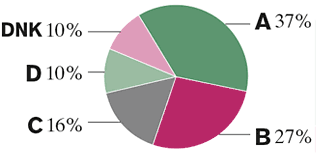 |
Which of the following opinions on students harassing students
with cyberbullying is closest to your own?
- Schools or boards should sanction students involved in harassing
other students online.
- Most or all incidents of cyberbullying should be reported
to the police.
- There’s not much that schools or boards can do to protect
students from other students harassing them online.
DNK (do not know/no opinion)
|
 |
Which of the following statements best describes any policy that
your school or board may have on how students may communicate on
the Internet and web sites or in e-mail and chat rooms?
- There are formal, well understood rules with potential consequences.
- There may be formal rules but they are not widely understood.
- There are informal rules.
- There are no rules.
DNK (do not know/no opinion)
|
 |
Do you communicate with parents by e-mail?
- never
- occasionally
- regularly
DNK (do not know/no opinion)
|
 |
Do you communicate with your students by e-mail?
- never
- occasionally
- regularly
DNK (do not know/no opinion)
|
 |
Which of the following describes your school’s or board’s
policy on teacher-student e-mail communication?
- There are formal, well understood rules with potential consequences.
- There may be formal rules but they are not widely understood.
- There are informal rules.
- There are no rules.
DNK (do not know/no opinion)
|
 |
Career satisfaction
How satisfied are you with:
| |
|
very satisfied |
very dissatisfied |
|
| |
| your teaching career |
4.2 |
39 |
44 |
11 |
3 |
2 |
1 |
| the job you are personally doing |
4.1 |
34 |
44 |
11 |
4 |
2 |
5 |
| the school you work in |
4.0 |
36 |
34 |
16 |
5 |
2 |
7 |
| the teaching profession as a whole |
3.9 |
23 |
50 |
22 |
3 |
1 |
* |
| the quality of Ontario’s education system |
3.5 |
8 |
46 |
37 |
6 |
2 |
1 |
* greater than zero and less than 0.5
Score the seriousness of each of the following challenges confronting
schools in Ontario today.
| |
|
most serious |
Least serious |
|
| |
| standardized testing |
2.9 |
11 |
18 |
31 |
20 |
17 |
4 |
| condition of school facility |
2.9 |
12 |
20 |
31 |
23 |
14 |
* |
| school safety |
2.9 |
9 |
22 |
31 |
23 |
15 |
* |
| classroom management |
2.8 |
8 |
20 |
32 |
28 |
13 |
* |
| inadequate time for classroom instruction |
2.8 |
10 |
18 |
28 |
28 |
15 |
1 |
| lack of resources |
2.8 |
7 |
19 |
31 |
27 |
15 |
1 |
| professional development to support diversified
classrooms |
2.8 |
6 |
20 |
34 |
26 |
12 |
2 |
| lack of parental support |
2.7 |
6 |
17 |
33 |
26 |
17 |
1 |
| unrealistic expectations |
2.6 |
4 |
15 |
32 |
29 |
19 |
1 |
| lack of respect for the profession |
2.5 |
4 |
16 |
29 |
32 |
19 |
* |
| integration of children with specialized needs |
2.5 |
6 |
12 |
27 |
29 |
25 |
1 |
* greater than zero and less than 0.5
Thinking about how your career might develop over the next five
years, how likely is it that you will be a teacher in five years’ time?
- very
- somewhat
- not really
- not at all
- has left for another occupation
DNK (do not know/no opinion)
|
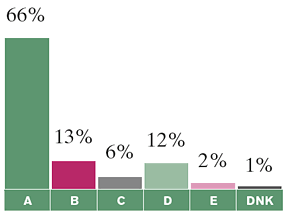 |
How likely are you to retire within five years?
- very
- somewhat
- not really
- not at all
- is retired
DNK (do not know/no opinion)
|
 |
Rank the following professions in order of most to least respected
by the public.
| |
|
most respected |
least respected |
|
| |
| doctors |
96 |
89 |
8 |
2 |
1 |
* |
1 |
0 |
| accountants |
24 |
4 |
27 |
36 |
27 |
5 |
2 |
* |
| lawyers |
17 |
3 |
38 |
20 |
16 |
9 |
15 |
* |
| teachers |
16 |
3 |
25 |
33 |
26 |
7 |
5 |
0 |
| real-estate agents |
-75 |
* |
2 |
6 |
15 |
42 |
35 |
0 |
| insurance agents |
-80 |
* |
1 |
3 |
15 |
37 |
44 |
* |
* greater than zero and less than 0.5
Do you perceive licensed teachers as receiving professional recognition
in the community that is commensurate with their education and contributions?
- definitely
- probably
- probably not
- definitely not
DNK (do not know/no opinion)
|
 |
Quality of education
Insofar as you can tell, compared to five years ago has classroom
quality improved, stayed the same or declined?
- improved
- stayed the same
- declined
|
DNK (do not know/no opinion)
|
 |
 |
Insofar as you can tell, has the policy of a primary-class size
cap been implemented in practice?
- definitely
- probably
- probably not
- definitely not
DNK (do not know/no opinion)
|
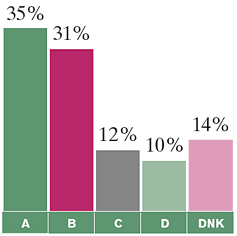 |
Insofar as you can tell, has the policy of a primary-class size
cap of 20 students had a positive effect on the quality of teaching
in the system?
- definitely
- probably
- probably not
|
- definitely not
DNK (do not know/no opinion)
|
 |
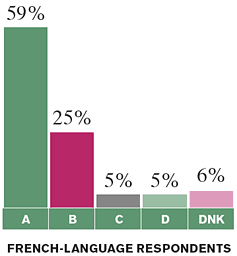 |
Supply and demand
To what extent is there an oversupply issue facing the teaching profession?
|
MEAN 2.7
|
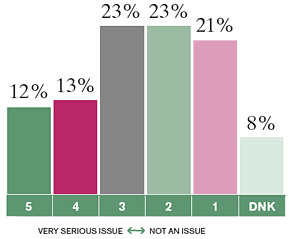 |
There are reports that 8,000 more new teachers are licensed each
year in Ontario than the number of teachers retiring from the profession.
How aware are you of this?
- very aware
- somewhat aware
- not really aware
- not at all aware
DNK (do not know/no opinion)
|
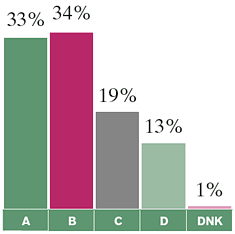 |
How important is it to control the number of newly licensed teachers
to a volume that can be absorbed by the education system?
|
MEAN 2.2
* greater than zero and less than 0.5
|
 |
Given the shortage of teachers in French, math, science and technology,
to what extent would you support a targeted enrolment strategy at
faculties of education?
|
MEAN 2.1
|
 |


